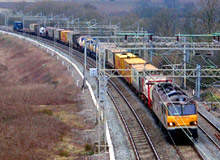
Eurostar has announced the official opening of its engineering centre in Temple Mills, London, in a climate that has already made the high-speed line the talk of the town. Commuters and businesses alike have been eagerly waiting for the opening of the record-breaking Eurostar line from St Pancras to France and Brussels in November this year.
And it is no surprise. The European high-speed network into London, one of the world’s most important financial and economic centres, is an international headline stealer for all the benefits that it brings for passengers.
HIGH-SPEED RAIL FREIGHT
But now, another transport revolution is poised to taking place alongside it – high-speed rail freight. The prospect of a trans-national European operator has moved closer to realisation with the announcement that Germany’s Deutsche Bahn (DB) is keen to take a controlling share in the Canadian / US / New Zealand-owned English, Welsh & Scottish Railway (EWS), which claims 70% of the UK rail freight market.
It is a clever move – EWS is one of only three companies licensed to run freight through the Channel Tunnel, and the other two – France’s SNCF and Eurotunnel – are not currently up to a great deal. DB is also exploring a deal with Spanish freight rail group Transfesa to extend its presence on the Iberian peninsula.
If the takeover takes place, DB will be able to extend its Raillion freight rail business deep into France (it is already active in the Netherlands and Denmark). It also fits in well with the European Commission’s desire for ‘open access’ for freight, a move hitherto resisted by the French, ever-keen to protect their industrial interests from overseas competition.
How well do you really know your competitors?
Access the most comprehensive Company Profiles on the market, powered by GlobalData. Save hours of research. Gain competitive edge.

Thank you!
Your download email will arrive shortly
Not ready to buy yet? Download a free sample
We are confident about the unique quality of our Company Profiles. However, we want you to make the most beneficial decision for your business, so we offer a free sample that you can download by submitting the below form
By GlobalDataONE EUROPE, NOT ONE RAILWAY
While mainland Europe embraces rail freight with a new degree of enthusiasm, there is recognition that market share is being lost because of long delays caused by unnecessary bureaucracy at national borders, lack of fast train paths through some counties, poor liaison and communication and a general lack of monitoring of wagons and their contents.
The European Commission believes that 20,000 of the continent’s 260,000km network could be opened up for fast international freight, and now insists that all applications for funding for high-speed lines are accompanied by a detailed plan of how downgraded classic routes can be used for developing freight flows. It also believes that the creation of international hubs will allow efficient shuttle services to be organised.
Frustratingly, the UK Government continues to prevaricate over large-scale investment. Since privatisation in 1993 there have been many years when no Freight Facilities Grants (FFGs) whatever have been awarded.
The widening of bottleneck cross-country routes to accommodate international-dimension (9ft 6in) containers shipped into the East Coast deep sea ports of Felixstowe, Tilbury and Immingham, plus Southampton on the south coast, is proceeding at a snail’s pace.
Contrast this to the Netherlands, where a brand new (Betuwe) route has been built into Rotterdam rather than widen the existing one.
The benefits of rail freight are well documented: a typical freight train removes 50 HGVs from our roads, and tonne for tonne, rail produces less than one-tenth of the carbon monoxide, 5% of the nitrogen oxide, and 10% of the volatile organic compounds. Lorries are also involved in 17% of road deaths.
US REALISES THE BENEFITS
In terms of coordination, the US is already embracing the issue of intermodal freight transportation, which is fighting back against road and airline domination. The Alameda Corridor, which services the West Coast ports of Long Beach and Los Angeles (third in the world behind only Hong Kong and Singapore with around $160m of business annually) is a celebrated example.
Severely congested rail routes and proliferation of level crossings meant painfully slow journey times until Federal loans were obtained for a $2.4bn makeover that has doubled speeds. It is also a vote winner because traffic delays have been cut by 90%. Attention has now turned to Chicago, where similar road / rail incompatibility exists.
It should never be overlooked that high-speed lines can accommodate freight as well as passenger services. Just ten years ago, the French LGV route between Paris and Toulouse was amongst the first to demonstrate this, at first running at 160km/h, and the only barrier to 200km/h operation was the availability of suitable wagons.


